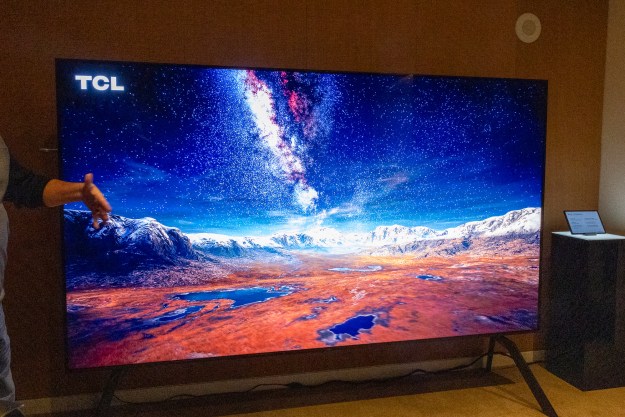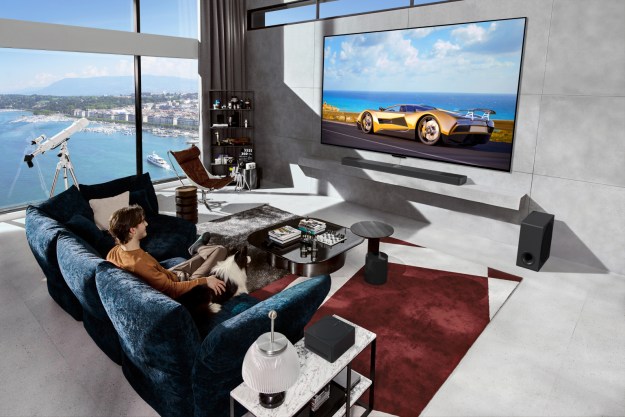With its monstrous 88-inch 8K OLED still sweeping headlines, LG has formally announced its full TV line for the new year, just a few days ahead of CES 2018. The lineup will see the return of the “Wallpaper” OLED, which saw significant attention and critical acclaim last year, along with three other OLED models and a full suite of LG Super UHD LED televisions. The common thread throughout most of LG’s 2018 TV line are significantly faster processors for better picture quality and overall performance and the addition of Google Assistant to the company’s smart TV platform, webOS.
Though processing may not be the most exciting discussion point for new TVs, it’s certainly one of the most important aspects pertaining to picture quality. Picture processing is what separates the good from the great and, sometimes, the decent from the deplorable. LG’s new a9 (read: Alpha 9) intelligent processor will mean better color rendering and super-fast smart TV operation for LG W8, E8, and C8 OLED TV owners, and a slightly scaled-down version will run the B8 OLED and LG’s Super UHD TV line.
Also along the smart TV vein is the addition of Google Assistant, which will take over for any voice inquiries that webOS can’t handle — the combined technology is being positioned as the Thinq AI system, and will fold in LG’s smart speakers and smart appliances as well. In 2018 you will be able to use normal language to tell your TV to turn itself off when the show you are watching is over, or change the channel to a specific network, but with the addition of Google Assistant, you could also order a pizza, call an Uber, view Google Photos, and check traffic through Google maps. The new TVs will also be addressable through other Google Assistant products like the Home and Home Mini speakers. LG says that its TVs will also be compatible with Amazon’s Alexa.

While LG’s 4K OLED lineup will look similar to last year’s models, the company’s Super UHD LED TV line is seeing some improvements which should have significant positive impact on picture quality. Most notably, LG is moving to use full-array local dimming backlights in the top two series and is touting an improved “nano cell” IPS display technology which not only reduces glare and reflections, but considerably improves off-angle color performance.
As for HDR, LG will continue its pledge to support most (but not all) HDR formats, with Dolby Vision, HDR10, HLG, and Advanced HDR by Technicolor all available in OLED and Super UHD TVs. HDR10+ is not supported this year and it isn’t clear if LG ever will support it.
Finally, 2018 sees the addition of high frame rate (HFR) enabling native playback of content at 120 frames per second (fps). Currently, there’s not much in the way of 120 fps 4K video, but some Hollywood types see it as a natural progression away from the 24 fps we’re used to seeing in film, and LG appears to be getting on board with the idea early. It’s important to note, however, that none of LG’s 2018 TVs support HDMI 2.1, so 120 fps for game consoles won’t be possible with any of these models — 120 fps content will only be available via streaming.
Here’s how LG’s OLED TV line looks broken down by series, features, and screen sizes:
| Series/Model number | W8 “Wallpaper” | E8 | C8 | B8 |
| Panel | OLED | OLED | OLED | OLED |
| HDR/HFR | 4K Cinema HDR + 4K HFR | 4K Cinema HDR + 4K HFR | 4K Cinema HDR + 4K HFR | 4K Cinema HDR or 4K HFR |
| Sound | Dolby Atmos 60-watt 4.2 channel | Dolby Atmos 60-watt 4.2 channel | Dolby Atmos 40-watt 2.2 channel | Dolby Atmos 40-watt 2.2 channel |
| Design | Picture-on-Wall | Picture-on-Glass | Blade Slim | Blade Slim |
| Smart | webOS with Google Assistant | webOS with Google Assistant | webOS with Google Assistant | webOS with Google Assistant |
| Sizes | 65- and 77-inch | 55- and 65-inch | 55-, 65-, and 77-inch | 55- and 65-inch |
Along the same lines, here’s what LG’s premium Super UHD LED TV line will look like in 2018:
| Series/Model number | SK9500 | SK9000 | SK8000 |
| Panel | Nano Cell Display | Nano Cell Display | Nano Cell Display |
| Dimming | Full Array Dimming Pro | Full Array Dimming | Local Dimming |
| HDR/HFR | 4K Cinema HDR or 4K HFR | 4K Cinema HDR or 4K HFR | 4K Cinema HDR or 4K HFR |
| Sound | Dolby Atmos processing | Dolby Atmos processing | Dolby Atmos processing |
| Smart | webOS with Google Assistant | webOS with Google Assistant | webOS with Google Assistant |
| Sizes | 55- and 65-inch | 55- and 65-inch | 55-, 65-, and 75-inch |
Finally, here’s the balance of LG 4K TV offerings:
| Series/Model Number | UK7700 | UK6500/70 | UK6300 |
| Panel | 4K IPS with Nano Cell | 4K IPS | 4K IPS |
| Dimming | Local dimming | Local Dimming on 55-,65-,70-inch | Local dimming on 55- and 65-inch |
| HDR | 4K Active HDR | 4K Active HDR | 4K Active HDR |
| Sound | Ultra Surround | Ultra Surround | Ultra Surround |
| Smart | webOS with Google Assistant | webOS with Google Assistan | webOS with Google Assistan |
| Big Screen Sizes | N/A | 70-,75-,and 86-inch | N/A |
| Sizes | 49-,55-, and 65-inch | 43-,50-,55-, and 65-inch | 43-,49-,50-,55-, 65-inch |
That’s it for our LG 2018 TV overview. Be sure to bookmark this article and check back next week when we’ll be updating this post with live, hands-on video of all the new models, including that 88-inch 8K OLED TV.
Update: Added video of the W8 Wallpaper OLED from CES 2018
Editors' Recommendations
- Sony debuts the Bravia 9, its brightest 4K TV ever, alongside new 2024 models
- Samsung QN900D 8K TV first look: fully loaded flagship
- You Asked: Samsung QD-OLED conundrum, ATSC 3.0, and audio outputs
- Panasonic’s latest OLED TVs are the first with Amazon Fire TV built-in
- Could LG’s 3000-nit OLED finally end the brightness wars?




